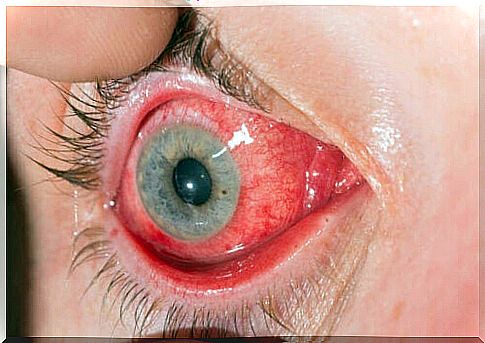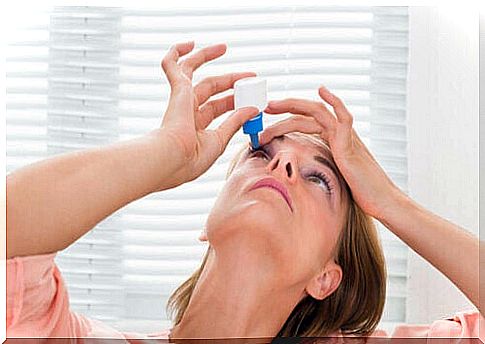Allergic Conjunctivitis: Symptoms, Causes And Treatment
Allergic conjunctivitis is a problem that affects many people. This is an overreaction of inflammation to exposure to agents such as pollen, dust mites, smoke, and the like.

Allergic conjunctivitis is a chronic inflammation of the conjunctiva, which is caused by an allergy to substances in the environment. It is regularly accompanied by rhinitis or inflammation of the nasal mucosa. In this case, we speak of rhinoconjunctivitis.
It is believed that around 25% of people have some degree of allergic conjunctivitis. Many people suffer from this problem at a time when the level of pollen in the air is higher. In this article, we explain the symptoms, causes and treatment of this disease to you.
Types of allergic conjunctivitis

The conjunctiva is the membrane that lines the eyelids and covers the white part of the eye. In this place there are a large number of cells of the immune system. Faced with environmental stimuli (such as pollen, smoke, mites, etc.), these cells release chemicals.
These cause the conjunctiva to swell, either briefly or for a long time. Sometimes the disease occurs on its own, but other times it is accompanied by other ailments. One of them is rhinitis, as already noted, but it can also be asthmatic bronchitis or eczema.
4 types of allergic conjunctivitis
There are several types of allergic conjunctivitis, depending on the agent causing it and the course of the disease. According to an article published in the Community Eye Health Journal , they are divided like this:
- Seasonal allergic conjunctivitis. It is thus the most typical form which is caused by the presence of pollen in the air. It affects people of all ages and usually appears in spring or summer and goes away during other seasons.
- Perennial allergic conjunctivitis. On the contrary, it is present all year round. In this case, the allergens are usually dust, smoke, mites, animal dander and feathers. There is another more complex form of conjunctivitis called keratoconjunctivitis.
- Spring keratoconjunctivitis. It is a disease that appears in hot climates. The most affected group is that of young men between 8 and 12 years old. This can be made worse by exposure to the sun, wind, or dust.
- Atopic keratoconjunctivitis. It is thus associated with atopic dermatitis, a skin reaction that often causes itching, swelling and redness. Atopic keraconjunctivitis affects the ocular surface and the eyelids. However, the conjunctiva and cornea can also be affected.
What are the symptoms ?
Most often, allergic conjunctivitis affects both eyes. As reported by the Australian Society for Clinical Immunology and Allergy, the characteristic symptoms of the disease are as follows :
- Itchy eyes
- Red eyes
- Burning eyes
- Aqueous discharge
- Intolerance to bright light
- Blurred vision in some cases
To establish the diagnosis, the patient’s symptoms are taken into account and an ophthalmological examination is performed. This consists of a slit lamp scan. To discover the causative agent, it is necessary to perform additional tests, such as conjunctival smear, prick test, conjunctival provocation test, among others.
Causes of allergic conjunctivitis
Allergic conjunctivitis is an overreaction of the immune system against a factor in the environment. When the eyes are exposed to the stimulus that causes the allergy, the body picks up on it and triggers a series of reactions that together constitute an inflammatory response.
There are additional agents, such as viruses, nervousness, spicy foods, light and the like, which often can lead to exacerbation of symptoms. These elements are harmless if the conjunctiva has not been inflamed beforehand.
Treatment

When the person already has allergic conjunctivitis, the important thing is to take the necessary steps to reduce exposure to the allergy-triggering factor and to provide basic care to reduce the symptoms.
According to the Community Eye Health Journal publication mentioned above, it is advisable to change pillows and rugs and replace any items that may contain the allergen.
Also, it is still advisable not to rub your eyes, in addition to applying cold compresses to reduce itching. The doctor may indicate the use of certain medications such as antihistamines, nonsteroidal anti-inflammatory drugs, topical corticosteroids, or artificial tears.
Although all of these measures can be helpful in coping with the symptoms. However, the best treatment for allergic conjunctivitis is prevention. The first thing to do is to identify the allergenic agent, thanks to the corresponding medical tests.
In any case, as we mentioned, it is best to keep the house clean, use synthetic textile bedding, and avoid pets, rugs, and stuffed animals. Now that you know this information, don’t hesitate to make the necessary changes to have a better quality of life.









